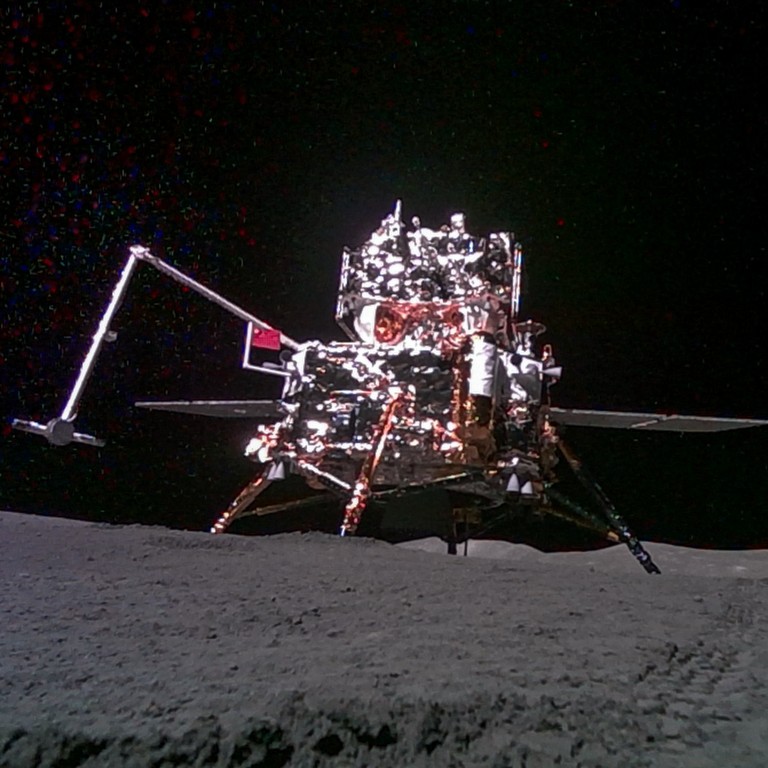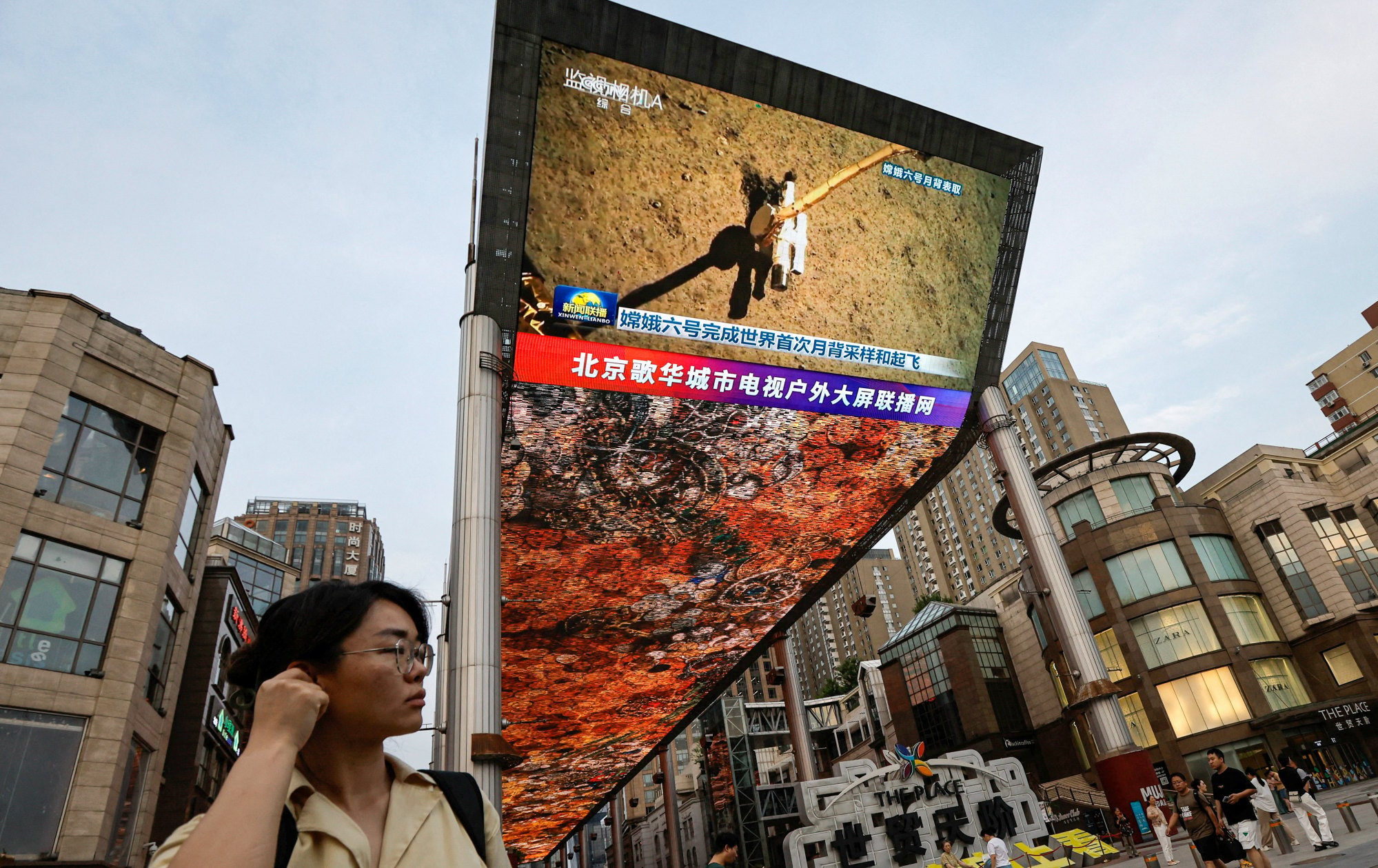
China calls the US a ‘competitor’ in moon race for first time, from a position of strength
-
-
China has outlined its lunar ambitions in a new plan, and for the first time has acknowledged it is in a race for the moon with the US
Stephen Chen in Beijing
Published: 6:00pm, 21 Jun 2024
China said it would never compete with the US on the moon. Now it has changed its mind.
In a new strategic lunar plan, the China National Space Administration (CNSA) has defined the United States as a competitor for the first time, signifying a big shift from the nation’s long-held discreet space policy to a position of rapidly growing strength.
Human exploration of the moon has always been competitive. It began with the tug of war between America and the Soviet Union during the Cold War.
“In the historical context of that period, the race to demonstrate superior political strength made lunar exploration unsustainable,” the plan said.
“It is foreseeable that in the next 20 to 30 years, China’s International Lunar Research Station and the US Artemis programme will compete in terms of technology and operational efficiency on the same historical stage and at the same geographical location (the south pole of the moon),” it said.
The new plan, “Strategic Concept of Resource Utilisation Development Route of the International Lunar Research Station”, was written under the leadership of Pei Zhaoyu, deputy director of CNSA’s Lunar Exploration and Space Engineering Centre, and published in the Chinese Journal of Astronautics in April.
“The utilisation of lunar resources will become the focus of the competition,” Pei and his colleagues said.
“And countries such as the United States do not have a distinct edge in this.”
Washington has long cast China as a rival in this new rush for the moon, seeing the race mainly as a land grab.
“It is a fact: we’re in a space race,” Nasa chief Bill Nelson said in an interview on China’s moon ambitions with Politico in January 2023.
“And it is true that we’d better watch out that they don’t get to a place on the moon under the guise of scientific research. And it is not beyond the realm of possibility that they say, ‘Keep out, we’re here, this is our territory,’” he said.
But China sees the game differently, according to Pei.

02:01
China’s Chang’e-6 touches down on far side of moon on mission to bring rock samples back to Earth
China’s Chang’e-6 touches down on far side of moon on mission to bring rock samples back to Earth
Beijing aims to replicate its earthly success by carrying out large-scale infrastructure construction on the moon. It will help establish technological, manufacturing and economic advantages to encourage more countries to stop following the United States and join China-led efforts to exploit lunar resources, according to the plan.
“The utilisation of lunar resources is a scientific challenge, a technological drive and an economic reward. Efficiency and benefit will be the core evaluation benchmarks, guiding the construction, operation and sustainable development,” Pei’s team wrote.
Lunar soil is exceptionally rich in titanium and iron, two metals that can be used to manufacture spacecraft components. China has also discovered plentiful water molecules in its recently obtained samples, a resource that the Apollo missions missed.
These hydrogen and oxygen molecules, trapped in lunar soil particles, indicated the potential presence of up to 270 billion tonnes of water resources on the moon, which could be used to produce rocket fuel, water and oxygen for astronauts, Chinese space authorities said on social media.
According to the latest plan, China will launch two large spacecraft in the next few years to conduct detailed explorations of these resources and validate key technologies for resource utilisation. By 2030, collaborative work between humans and intelligent machines is expected to be achieved on the lunar surface.
Starting in 2035, China plans to “carry out large-scale energy acquisition, large-scale material extraction and large-scale lunar-based construction” to achieve “engineering applications such as oxygen and water production from lunar soil, mineral resource collection and extraction, metal-based component production, and lunar-based building construction”.
A “lunar-based resource exploration system covering a wide area of thousands of kilometres and a depth of hundreds of metres” will also be completed in this period.

By 2045, China’s lunar base will have large facilities such as power plants, factories, scientific research institutions, rocket launch sites, tourist centres and a small underground city.
Chinese resource exploration robots will roam the entire lunar surface. It is estimated that more than half of the investment in the construction and operation of these facilities will come from countries other than China, and economic activities will reach a break-even point. Humans will use this base as a starting point to explore Mars.
“China will become a leader in human deep space exploration activities,” the plan said.
China’s first lunar probe, Chang’e-1, was launched in 2007. Because of a lack of experience and confidence, this small, two-tonne satellite circled around the Earth for more than two weeks before heading to the moon.
Immediately after the launch, then-commander-in-chief of the lunar exploration project, Luan Enjie, told Xinhua News Agency: “China will not engage in any form of lunar competition with any country.”
Yet it took less than 15 years for the balance of space power to shift. China has sent a rover to Mars, established the BeiDou Navigation Satellite System to compete with GPS, and deployed the world’s largest Earth observation satellite network capable of tracking F-22 stealth fighters.
It has also completed the construction of an independent space station – something the United States has never achieved – and developed the world’s only high-orbit communication satellite that can directly connect millions of smartphones on Earth at a distance of 36,000km.
China’s lunar exploration programme has also reached world-leading milestones. Last month, the Chang’e-6 spacecraft gracefully touched down on the far side of the moon, where no other countries have gone, and collected rocks and soil. These samples will soon return to Earth.

02:14
China’s Chang’e 6 launches historic mission to collect first rock samples from far side of the moon
China’s Chang’e 6 launches historic mission to collect first rock samples from far side of the moon
Although the United States started lunar exploration earlier, due to mission delays and funding limitations, “it has lost its absolute leading position”, Pei’s team wrote.
To counter China’s advances, the US government has entrusted private enterprises with critical lunar missions, believing they can construct a lunar base more efficiently than Nasa. To motivate these private players, the US Congress enacted a law affirming the principle: “First to explore, first to own.”
However, the two initial private US moon missions have stumbled. Astrobotic Technology’s Peregrine lunar lander, the first US spacecraft to attempt a moon landing in decades, burned up in a failed attempt. Intuitive Machines’ Odysseus lander also encountered technical difficulties and tipped over after landing at a speed higher than expected.
The US Artemis programme includes a space station named Gateway orbiting the moon. However, the feasibility of this plan has been met with scepticism in China’s space community, as the United States has never successfully built a complete space station, even in Earth’s orbit.
The US Skylab space laboratory operated for less than a year before it crashed, and the core technology of the International Space Station is provided by Russia.
SpaceX’s Starship has achieved significant success in test flights. Although this giant spacecraft still requires further testing and technological breakthroughs to fly to the moon, some Chinese aerospace engineers believe it is the United States’ greatest hope in the race.

